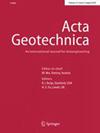Bayesian approach for probabilistic-based characterization of the shear stiffness–deflection curves of adhesive particle contacts
Abstract
The assessment of shear stiffness characteristics at the contact of particles is important in multi-scale modeling of geological materials and other problems involving powders and grains. Generally speaking, the Mindlin–Deresiewicz model is very often used to fit the shear load–deflection response curves for non-conforming contacts; however, this model does not provide an accurate fitting for coated or partially cemented sand grains. These materials displace a significant variation in their mechanical and morphological features resulting in scattered roughness profiles and micromechanical response. This brings high uncertainty in the assessment of their shear load–deflection behavior, as previous studies have shown a difficulty to clearly define a steady-state response (based on Coulomb’s friction criteria) which is the theoretical basis for the Mindlin–Deresiewicz model. Therefore, we propose in this work, a novel Bayesian-based probabilistic approach to analyze and select the best suitable model among three modified hyperbolic models to fit the shear load–deflection curves for coated or partially cemented grains. For this purpose, the shear load–deflection response of the contacting grains is presented in terms of secant stiffness curves. An objective procedure was followed to optimize and select the most appropriate analytical model for the given dataset analyzed in the study.

 求助内容:
求助内容: 应助结果提醒方式:
应助结果提醒方式:


